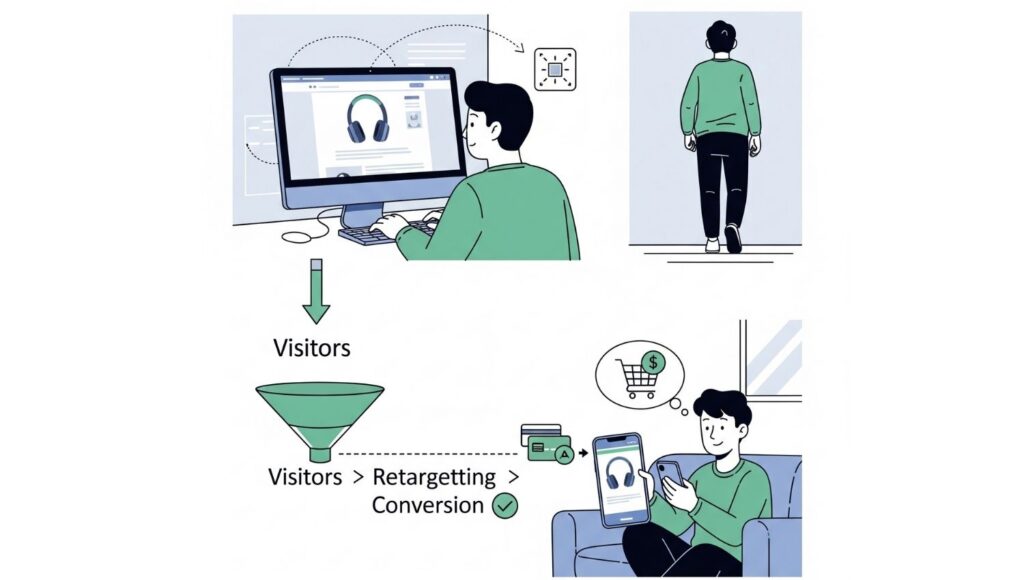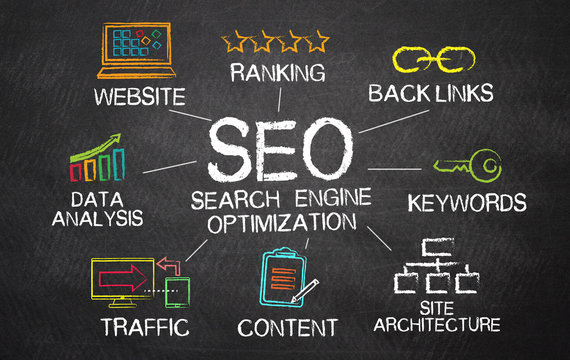Retargeting Ads: Converting Visitors into Buyers
Table of Contents

Think about this: a person comes to your site, browses around your product, perhaps even puts an item in their cart—and then doesn’t convert. Ring any bells?
Not often, perhaps?
Well, that’s the tale of 97% of first-time visitors. They bounce without converting.
But the good news is that they don’t have to be lost forever. With retargeting ads, you can bring them back, re-engage their interest, and at last turn them into loyal customers.
In this comprehensive guide, we’ll deconstruct:
- What retargeting ads are
- Why they’re powerful
- Types of retargeting campaigns
- Platforms you can use
- Best practices
- Real-world examples
- And how to get started step by step
Let’s unleash the power of converting retargeting.
What Are Retargeting Ads?
Retargeting (or remarketing) is a type of online advertisement that targets users who have already engaged with your website, app, or content but failed to take a desired action—such as buying, signing up, or downloading.
These ads track users across the web through:
- Display ads
- Social media ads
- Search ads
- Email remarketing
- And even YouTube pre-roll ads
The objective? Win back attention and push them back to convert.
Why Retargeting Ads Work So Well
Individuals seldom make buying decisions on the spot. Retargeting is successful because it leverages:
- Familiarity: Users are familiar with your brand.
- Relevance: You present them with ads that are relevant to their past actions.
- Repetition: It sometimes takes 5–8 touches to convert a lead.
- Personalization: Targeted ads based on individual product or page views.
Key Benefits:
- Boosts conversion rates
- Lowers cart abandonment
- Increases brand recall
- Drives maximum ROI from current traffic
- Increases overall marketing performance
“Retargeting is not about pushing. It’s about gently reminding.”
Understanding the Retargeting Funnel
Let’s simplify this into a simple funnel:
1. Awareness – Visitor comes to your website for the first time
→ You follow up on them via a pixel or cookie.
2. Consideration – They look at products/services
→ Retargeting takes over and displays similar ads on other sites.
3. Decision – They click the retargeted ad
→ Come back to site with greater intent.
4. Action – They convert (buy/sign-up).
Let’s move on to the various types of retargeting now.
Types of Retargeting Ads
1. Pixel-Based Retargeting
Involves setting a tiny snippet of code (a pixel) on your site to anonymously monitor visitors and display ads to them in the future based on their activities.
- Ideal for: E-commerce, service companies, and SaaS.
- Functions on platforms such as Facebook, Google, LinkedIn, and more.
2. List-Based Retargeting
Reach users from a list you upload (e.g., email subscribers or previous buyers). Only shows ads if the user is logged into the site with the same email.
- Ideal for: Newsletter subscribers, loyalty efforts, or upselling.
3. Dynamic Retargeting
These ads show exact products or services a user has looked at. Example: You looked at a shoe on an online retailer, and the same exact shoe shows up in your Facebook feed.
- Best for: E-commerce websites with a product catalog.
4. Search Retargeting
Reaches users who’ve searched for similar keywords but have not yet visited your site.
- Best for: Growing brand awareness among high-intent viewers.
5. Social Media Retargeting
Utilizes social channels such as Facebook, Instagram, and LinkedIn to serve up targeted retargeted content.
- Best for: Visual ads, engagement campaigns, and storytelling.
6. Video Retargeting
Targets viewers who’ve watched your video content on social media or YouTube.
- Ideal for: Storytelling, tutorial, or demo brands.
Retargeting Platforms You Can Use
Following are the best retargeting platforms and how they compare:
1. Facebook and Instagram Ads
- Retarget viewers who visited your page, carted, or interacted with posts.
- Very visually centric with carousel, video, and image ad types.
- Suitable for wide and segmented audiences.
2. Google Ads (Display & Search)
- Retarget to the Google Display Network (over 2M sites).
- Features Gmail ads and YouTube ads.
- Dynamic product ads supported.
3. LinkedIn Ads
- Suitable for B2B retargeting.
- Enable retargeting by website visits, engagement, or video views.
4. YouTube Ads
- Retarget video audiences with pre-roll or discovery ads.
- Good for brand awareness and recall.
5. Twitter/X Ads
- Effective for users who’ve interacted with your tweets or visited your website.
6. Email Retargeting
- Retarget with follow-up emails users who abandoned carts, looked at products, or downloaded lead magnets.
Step-by-Step Guide to Setting Up a Retargeting Campaign
Step 1: Install Tracking Pixel
- Utilize Facebook Pixel, Google Tag, or LinkedIn Insight Tag on your site.
- Put the code on all major pages (homepage, product pages, thank you page, etc.).
Step 2: Build Custom Audiences
Examples:
- All site visitors in the past 30 days
- Cart abandonment (visitors who added to cart but didn’t check out)
- Blog readers who lingered longer than 2 minutes
Step 3: Determine Campaign Goals
Determine the conversion objective:
- Add to cart
- Make a purchase
- Book a demo
- Download an ebook
Step 4: Design Ad Creatives
- Align messaging with user behavior (don’t use the same creative for all).
- Make headlines simple and CTAs action-oriented.
- Utilize urgency or scarcity (e.g., “Only a few left!”).
Step 5: Set Budget and Bidding
- Scale small and scale with performance.
- Employ CPC or CPM bidding depending on your goal.
Step 6: Launch and Monitor
- Monitor impressions, clicks, conversions, and return visits.
- Optimize according to performance.
Best Practices for High-Converting Retargeting Ads
1. Segment Your Audience
Don’t treat everyone the same. Someone who visited a blog post is completely different than someone who left a cart behind.
Pro Tip: Send specific messages per funnel stage.
2. Use Frequency Capping
Don’t show the same ad over and over again. It can cause ad fatigue.
3. Rotate Creatives Regularly
Refresh ad visuals and copy every 2–4 weeks to keep users interested.
4. Incentivize Return
Provide discounts, free shipping, or bonus content to drive conversions.
5. Align Landing Pages with Ads
Make sure the landing page users land on aligns with the message in your ad—this increases trust and conversions.
6. Test Everything
A/B test:
- Headlines
- CTA buttons
- Offers
- Images
Metrics to Track in Retargeting Campaigns
- Click-through rate (CTR)
- Conversion rate
- Return on ad spend (ROAS)
- Frequency
- Cost per acquisition (CPA)
- Bounce rate
Monitoring these metrics will keep you refining your retargeting approach continuously.
Real-World Example
E-commerce Brand: Fashion Store
Challenge: 70% cart abandonment
Solution: Ran Facebook dynamic retargeting ads to users who added to cart but did not buy. Ad contained a 10% off code usable within 48 hours.
Result:
- 41% of abandoners returned
- 27% made purchase
- ROAS grew 3.5x within 2 weeks
SaaS Business: Project Management Tool
Problem: Free trial customers not converting to paid
Solution: Built LinkedIn retargeting ads with case studies of successful customers + time-limited offer.
Outcome:
- Lead-to-customer conversion went up by 22%
- 1.9x boost in demo requests
Common Retargeting Mistakes to Avoid
- Displaying the same ad to all
- Not excluding already converted users
- Mobile optimization being ignored
- Utilizing a generic CTA
- Failing to test ad copy variations
- Retargeting too early (before people are ready)
Retargeting and the Buyer’s Journey
| Stage | User Action | Retargeting Strategy |
| Awareness | Went to blog or homepage | Instructional ads, guides |
| Consideration | Looked at product/service | Testimonials, case studies |
| Decision | Put in cart | Discount code, sense of urgency |
| Loyalty | Purchased | Upsell/cross-sell |
Optimizing your ads to reflect user intent increases conversions with less ad spend.
Retargeting + Other Channels
Retargeting performs best in combination with:
- Email automation: Abandon cart sequences, re-engagement emails
- Content marketing: Leverage readers of blogs as warm retargeting audiences
- Search ads: Amplify visibility for high-intent searchers
- Organic social: Make users familiar so retargeting happens sooner
Everything works better when it’s tied together.
Future of Retargeting: Privacy & Cookieless Era
With more emphasis on user privacy and deprecation of third-party cookies, retargeting is changing.
What You Can Do:
- Create first-party data through email sign-ups, subscriptions
- Use server-side tracking
- Employ contextual targeting as a privacy-respecting alternative
The future is one of personalization vs. privacy.
Recap Checklist: Setting Up Retargeting Ads
- Install tracking pixel
- Create custom audiences
- Segment by behavior
- Write engaging ad copy
- Align landing page with ad intent Set frequency caps
- Optimize and monitor
- A/B test everything
- Sync with email and content marketing
- Prepare for privacy-first tracking
Final Thoughts
Retargeting is among the most affordable and effective tools in your digital marketing arsenal. If you’re not leveraging it, you’re losing out on high-intent customers who are already familiar with you.
They came to your site for a reason. Retargeting just provides them one more opportunity to say yes.
Don’t lose your traffic. Leverage smart retargeting tactics to transform curiosity into conversion.


